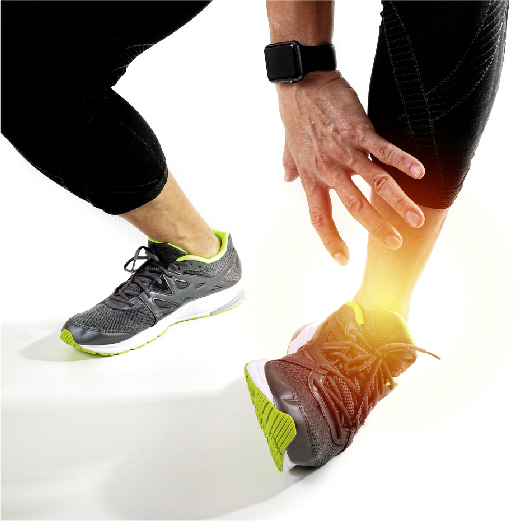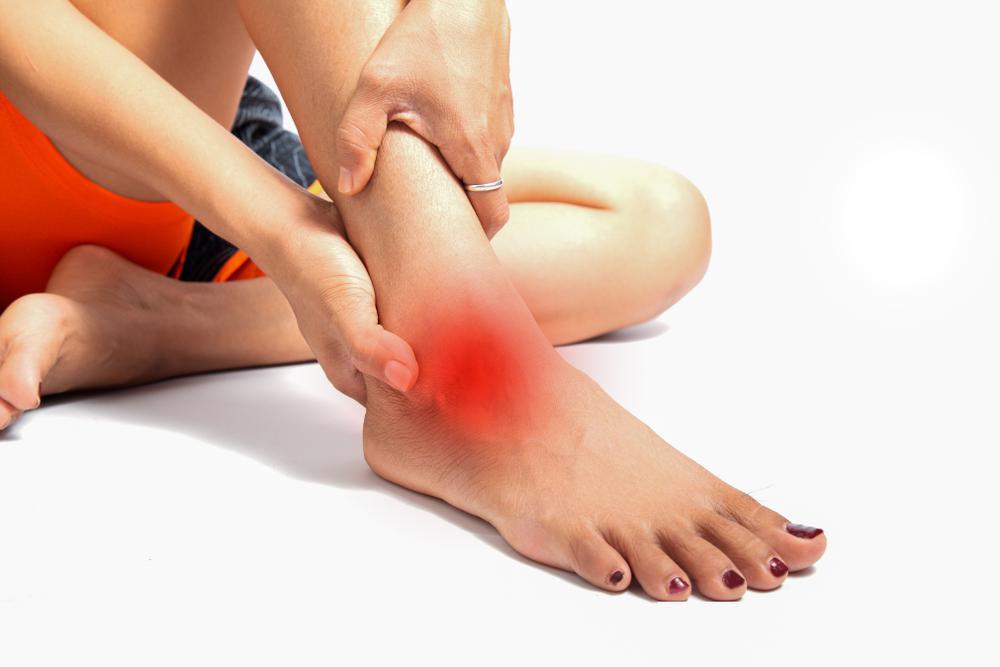
Shin Splints
Shin-splints is a commonly seen in runners or walkers, although it can affect anybody. It is characterised by a dull pain along the front or inside of the tibia, or shin-bone.
Muscular imbalances around your shin, shoe choices or sudden increases in your running load are often the cause. Talk to your physiotherapist about what the best management plan for you will be.
Musculoskeletal Physio for Plantar Fasciitis Treatment
The plantar fascia is a thick band of connective tissue that is located on the under-surface of our foot.
It is highly important in absorbing our weight as we walk, run and jump, as well as propelling us forward. It is an important structural piece in our longitudinal arch. The plantar-fascia is designed to handle quite large forces, but when it experiences abnormally large loads, or is strained over time, it can be a common source of pain.


Ankle Sprains
The ankle-joint requires a lot of different ligaments to keep it stable, preventing too much movement from side-to-side.
Often during high-velocity movements, or during sport, the ankle can get stretched outside of the limits of these ligaments. In these cases, the ligaments can become stretched, strained or torn. This can result in pain and instability at the ankle joint. Talk to your physiotherapist about the best management plan for your ankle strain.
Achilles
The achilles tendon is located at the back of the heel, connecting the muscles in your calf to your calcaneus (heel bone).
It is the largest tendon in your body and transfers a lot of force into the foot, helping us to walk, run and jump. Tendons are designed to take a lot of force, but in cases where there is repetitive force and load, the achilles tendon can respond and develop pain. This is called Achilles Tendinopathy.

Tendon Injuries Beyond the Achilles
While the Achilles tendon is well-known, other tendons in the foot and ankle are also prone to injury, particularly with overuse or sudden acute injuries. Tendon injuries, such as Peroneal Tendinopathy or Posterior Tibial Tendon Dysfunction, can cause pain, instability and limit your mobility.
Tendon injuries often stem from poor ankle stability, flat feet or imbalances in the lower leg. They require a combination of manual therapy, strengthening and gradual load management to achieve a successful outcome.
We develop your physiotherapy treatment plan to restore strength, prevent re-injury and improve your entire body’s functional movement.


Stress Fractures and Stress Reactions
Stress fractures and stress reactions are common overuse injuries in the lower leg, foot and ankle. They occur when repetitive stress exceeds the bone’s ability to recover, leading to microscopic cracks. Without appropriate physiotherapy treatment, these small cracks can progress to complete fractures.
Physiotherapists can assist in early diagnosis, offloading strategies and gradual rehabilitation exercises to ensure a successful outcome.
Left untreated, these injuries may compromise the stability of the ankle and foot, impacting your entire body’s biomechanics.
Common signs include:
- Persistent lower leg or foot pain during or after activity
- Tenderness over a specific bone
- Swelling without bruising
Our approach focuses on targeted physiotherapy management, ensuring your well-being while supporting a full and strong return to activity.
Flat Feet and Arch Instability
Flat feet (fallen arches) can have a major influence on your ankle, knee and hip alignment. Poor arch support often leads to plantar heel pain, ankle ligament strain and can even contribute to stress fractures over time.
Symptoms of flat feet may include:
- Heel, arch or ankle pain
- Tired, aching feet after standing or walking
- Poor balance or frequent ankle sprains
Treatment may involve manual therapy, strengthening exercises (such as calf raises and arch strengthening drills), and footwear advice to support your lower leg and ankle stability.

Overuse vs Acute Injuries
Foot and ankle conditions can generally be classified as either acute injuries (like ankle sprains or acute stress fractures) or overuse injuries (like shin splints, plantar fasciitis or tendon injuries).
Understanding the difference is essential for choosing the right physiotherapy treatment.
Acute injuries typically require early protection, manual therapy and gradual reloading.
Overuse injuries demand careful load management, biomechanical correction and strengthening programs.
No matter the cause, your injured foot deserves a custom treatment plan to maximise recovery, minimise downtime and promote overall well-being.
How Foot Physios Treat Foot and Ankle Pain
Every injured foot or ankle condition requires a tailored approach to achieve the most successful outcome. At M Physio, our experienced foot physiotherapists use a wide range of treatment techniques to address the cause of your pain, not just the symptoms.
Common treatment methods include:
Manual Therapy
Hands-on joint mobilisation, soft tissue release and trigger point therapy improve foot, ankle and lower leg mobility. Manual therapy also reduces swelling, restores normal biomechanics and accelerates healing for acute injuries and overuse conditions alike.
Exercise-Based Rehabilitation
Targeted exercises such as calf raises, intrinsic foot strengthening and single-leg balance drills are essential to restore ankle stability and prevent re-injury. Strengthening the entire lower leg also supports the foot’s arch and improves movement efficiency across the entire body.
Proprioceptive and Balance Training
After ligament injuries or sprains, restoring balance and ankle control is critical. Specific balance and agility drills help prevent future ankle conditions by improving joint position awareness and dynamic stability.
Load Management and Return to Activity Planning
For stress fractures, stress reactions, plantar fasciitis and tendon injuries, a gradual return to running, walking or sport is carefully managed. This ensures tissue healing while preventing further stress on the injured structures.
At every step, our foot physio programs are designed to promote healing and support a pain-free, active lifestyle.
Foot Physio FAQs
Is my foot and ankle pain serious?
If you haven’t received any major or repetitive trauma to your foot or ankle, then it is likely that you will make a full recovery with conservative physiotherapy management. The length of time taken to recover depends on your specific presentation, but most will significantly improve within 3 months. In the cases of more serious trauma or instability at the foot or ankle, surgery may be required. Talk to your physiotherapist about the specific prognosis for your injury.
Do I need a scan for my foot or ankle Injury?
Most likely not. A large majority of pain in the foot or ankle doesn’t come from any structural damage. Your physiotherapist will be able to do a thorough examination of your foot and ankle, and help give you a diagnosis and treatment plan. If they feel that a scan is needed, they will be able to help you by organising a referral to receive one. If you have high levels of pain after injuring your foot or ankle, get the opinion of a health professional about the best option for you.

